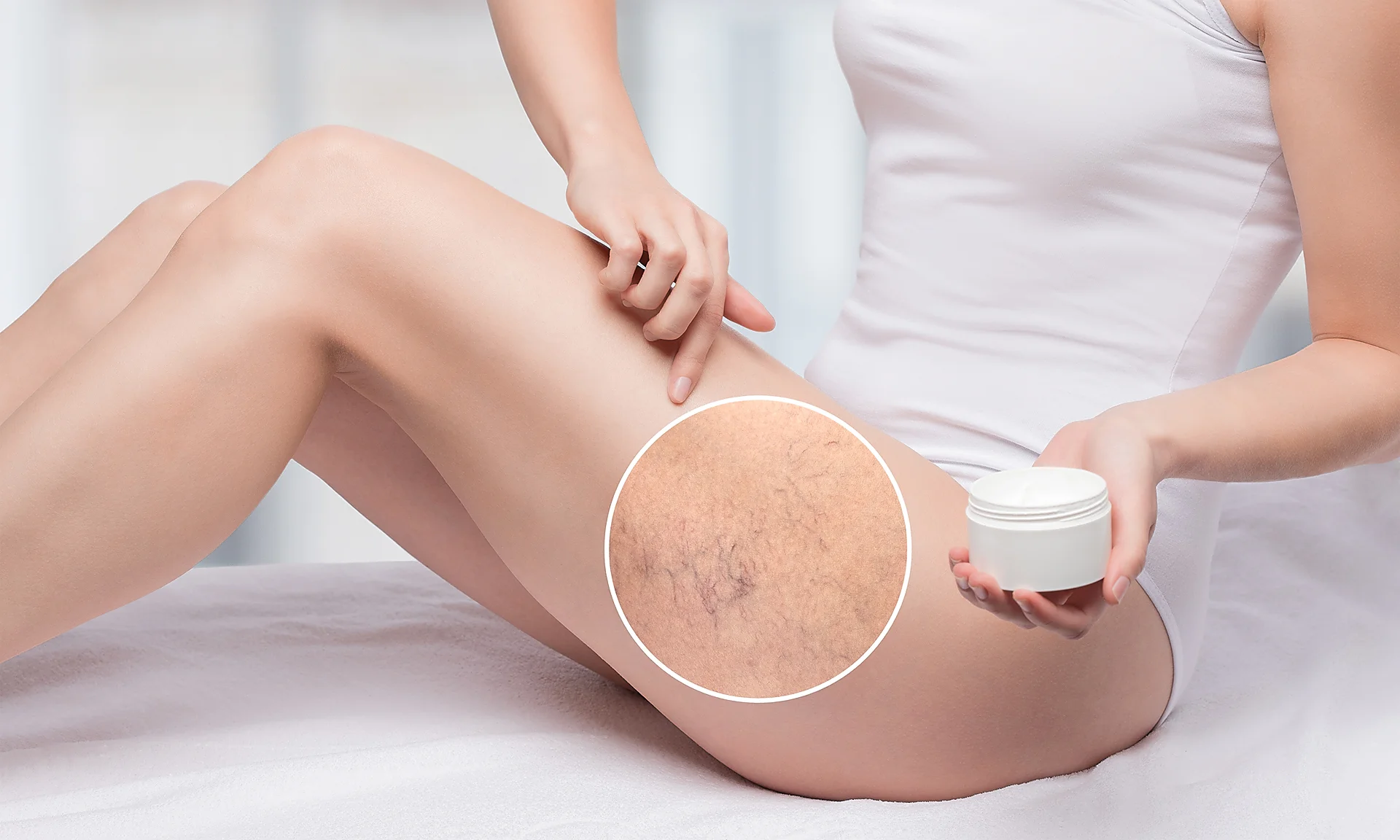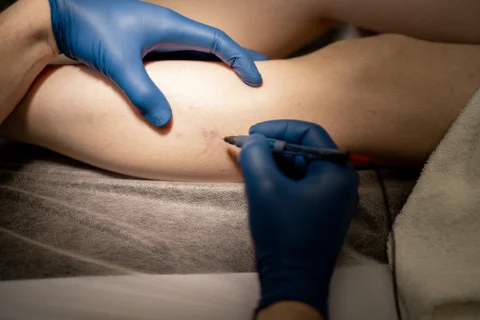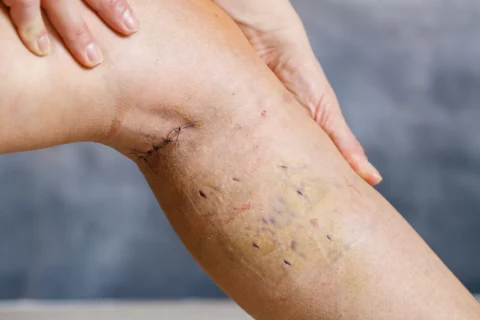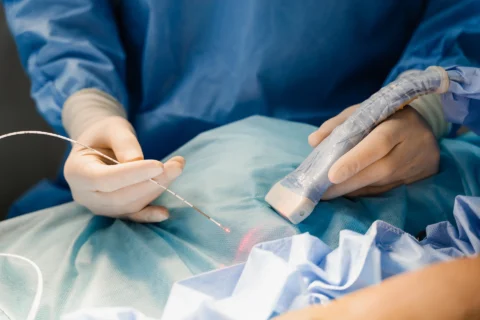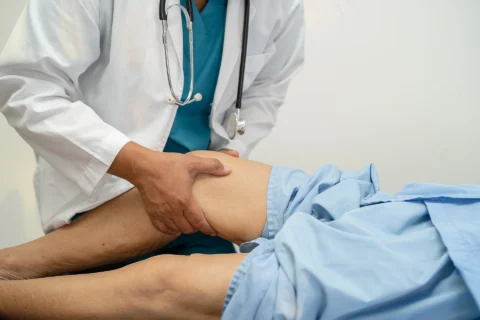Chronic venous insufficiency (CVI) occurs when valves fail to maintain unidirectional blood flow from the veins to the heart. This typically occurs in leg veins and manifests through symptoms such as varicose veins and leg ulcers. It is caused by a multitude of factors such as a sedentary lifestyle, obesity, and a history of deep vein thrombosis (DVT)
So what are the different treatments for chronic venous insufficiency? Venous insufficiency can be difficult to diagnose, especially since its symptoms don’t quickly progress, and it undergoes different stages of symptoms. In many cases, chronic venous insufficiency requires a combination of conservative treatment methods and intervention methods in the outpatient setting.
What Is the Treatment for Chronic Venous Insufficiency?
Patients with chronic venous insufficiency can experience a multitude of symptoms progressing as time passes by. In its early stages, you may experience leg pain or see varicose vein and spider vein protrusions in the skin.
These are all due to your valves’ failure to contain backflow in the deep veins and the superficial vein system. In severe cases of chronic venous insufficiency, the patient experiences leg edema, leg venous ulceration, and flaking of the skin in the lower legs.
As such, different treatments are used to remedy chronic venous insufficiency. Sometimes, a combination of conservative and intervention treatments is used in severe and non-compliant cases. Below are treatment techniques that are proven effective in healing chronic venous insufficiency:
Conservative Management
Conservative management of chronic venous insufficiency consists of non-invasive techniques aiming to reduce symptoms and improve the quality of life of patients while preserving all organ functions. These techniques aim to prevent the progression of chronic venous insufficiency to worse symptoms and stages. Conservative therapy includes wound and skin care, pharmacological therapy, structured exercise therapy, and manual lymphatic drainage massage.
1) Wound and Skincare
In its later stages, venous reflux can cause an accumulation of blood clots in skin and muscle tissues, leading to edema and venous ulcers. This can lead to breaks in the skin causing infection, flaking, and bruising.
In these cases, it’s necessary to remedy the skin damage by applying topical moisturizers to reduce skin flaking and fissuring. In cases of venous stasis ulcers, hydrocolloids and foam dressings can also help heal leg ulcers.
2) Pharmacological Therapy
Blood flow and venous integrity can be improved with the prescription of venoactive drugs. These substances can reduce capillary permeability, regulate platelet coagulation, improve venous tone, and moderate inflammatory response in leg veins. When combined with compression therapy, venoactive drugs can aid in relieving venous disease leg pain, and venous ulcer.
Coumarins, flavonoids, and saponosides are common examples of these venoactive substances. Other drugs such as aspirin, diuretics, and pentoxifylline can also aid in improving blood flow, reducing blood clot accumulation, improving fluid draining, and moderating inflammatory response.
3) Exercise Therapy
Venous pressure and blood flow in the leg veins are regulated by calf muscle pump function. A 2004 study has proven the effectiveness of structured exercises in improving calf muscle pump function and strengthening the calf muscles, which in turn, helps reorient the incompetent valves as well.
Leg raises, lunges, walking, and cycling are other low-impact exercises that can improve blood flow and reduce symptoms of chronic venous insufficiency. However, strenuous activities are not recommended for chronic venous disorder patients, as these may aggravate venous hypertension.
4) Manual Lymphatic Drainage
Manual lymphatic drainage is a skin-stretching massage technique mainly used for lymphedema patients, and can also be helpful in dealing with varicose veins and venous ulceration. This technique involves the promotion of lymph flow in the lymph vessels whose functioning is, according to a 2004 study, directly connected to the blood vessel system through the capillary exchange.
Blood flow in the leg veins and the functioning of vein valves can be improved through the smoother lymph flow promoted by manual lymphatic drainage, aiding the treatment of varicose veins and preventing the appearance of leg ulcers.
Advanced Outpatient Vein Treatment Interventions With Vein Center Doctor

When your case of chronic venous insufficiency proves unresponsive to conservative management techniques, your healthcare provider might consider applying intervention techniques. Here at Vein Center Doctor, we offer excellent outpatient treatment options without the hassle of long and painful downtime, unlike in vascular surgery procedures.
1) Compression Therapy
Compression therapy is an integral component of standard chronic venous insufficiency treatment. Through the help of garments such as compression stockings, compression therapy applies about 30 to 40 mmHg pressure between the foot and the knee to facilitate upward and unidirectional venous blood flow to the heart.
Compression stockings and bandages provide venous reflux patients with a multitude of benefits:
- Reducing leg pain and swelling
- Decreasing the occurrence of varicose veins
- Reducing fluid build-up and alleviating venous leg ulcers
- Improving blood flow and defying gravity-caused backflow
- Supporting calf muscle pump function
1) Sclerotherapy
Sclerotherapy is an outpatient intervention treatment employing sclerosing agents such as 23.4% sodium chloride and sodium iodide to treat varicose veins due to chronic venous disease. These sclerosing agents, when injected into the affected veins, induce their dehydration, turning them into scar tissues to be absorbed by the body. After the diseased vein is closed, blood will be rerouted to a healthy vein.
2) Endovenous Laser Ablation
Endovenous laser ablation employs thermal energy to treat varicose veins. During the procedure, your healthcare provider will first administer local anesthesia. Then through ultrasound-guided imaging, a catheter will be inserted into the affected vein, allowing for the entry of a laser fiber. This laser fiber then cauterizes the vein wall, closing off the diseased vein, after which blood flow will be redirected to a healthy vein.
3) Radiofrequency Ablation
Radiofrequency ablation works with a similar procedure to laser ablation; except it uses a radiofrequency catheter with the heating element at its tip to destroy the damaged vein.
Thermal ablation methods for venous disease are minimally-invasive and have little to no downtime. At worst, it may cause side effects such as infection and bruising in the treatment area, but these will go away after a few days. Like many intervention methods, vein ablation best works in conjunction with compression stockings.
4) VenaSeal
Another new innovation for venous disease is the VenaSeal closure system. It involves the use of the VenaSeal adhesive in closing off the damaged leg vein. Through ultrasound imaging, a catheter delivers 3 cm of this adhesive into the varicose veins at 3-second intervals until the entirety of the vein is covered.
Similar to the other outpatient methods, it induces scarring of the damaged vein and its eventual absorption into the body and the rerouting of blood flow to healthy veins. After the procedure, compression stockings or bandages will also be placed into the treatment area for the patient’s recovery.
Chronic Venous Insufficiency: Signs and Symptoms
In diagnosing and treating chronic vein disease, it’s important to recognize that this illness’s symptoms progress through different stages. Visible signs can be recognized alongside the symptoms of chronic leg pain, itchiness, and heaviness. According to the CEAP consensus, below are the stages of chronic venous disease and their respective symptoms.
- C0: No visible sign of CVI
- C1: Reticular veins and spider veins
- C2: Varicose veins
- C3: Edema in the lower leg
- C4: Skin changes (edema, lipodermatosclerosis, corona phlebectatica)
- C5: Self-healing venous leg ulcers
- C6: Active and recurrent venous leg ulcers
Start Your Journey to Optimal Vein Health With Vein Center Doctor

Chronic venous disease can prove troublesome and even fatal in the long run if its symptoms are left untreated. Our vein specialist team at Vein Center Doctor, led by Dr. Rahul Sood, ensures that our patients get the best possible treatment for their specific cases.
With our wide range of outpatient vein treatment options, we can treat varicose veins and other vein diseases of any stage. Live pain-free and get back your smooth and clear skin by reaching out to us today for a free consultation.

